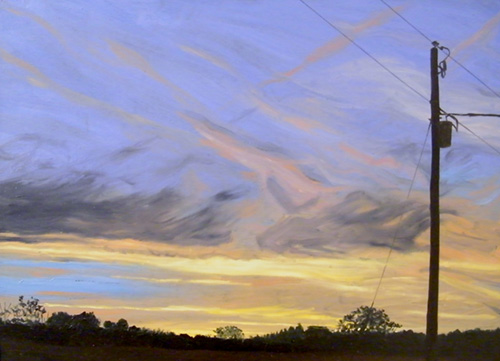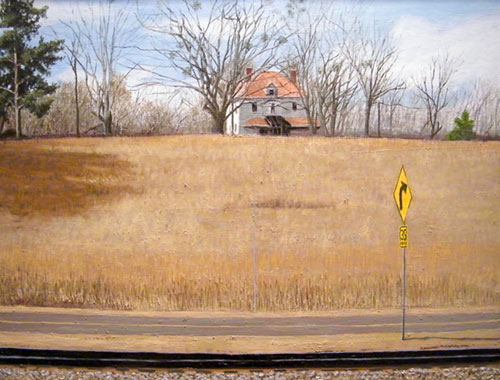Every location an artist chooses to paint has a unique voice and character. Artist John Cleaveland Jr. has nearly perfected the ability to transport his audiences into the deep American South in his paintings, revealing profound natural beauty and the ever-present effect of the human hand.
One would be hard-pressed to find anyone who does not feel an emotional, spiritual, or spatial connection to the place they live or grew up in. Whether the grassy plains of Missouri, the rocky coast of Northern California, or the mountain vistas of Colorado, many artists rely on this environmental link for artistic inspiration. Even so, capturing the personality and charm of a location requires acute attentiveness, familiarity, and both tangible and intangible skills. Lucky for us, John Cleaveland, Jr., possesses all of these and more, and his marked ability to tell the tale of rural Georgia has given audiences pictures with stunning clarity, asking us to stop our routines and appreciate the beauty that surrounds us.

John L. Cleaveland, Jr., “Short Leaf Pine,” oil on panel, 11 x 12 in. (c) Blue Spiral 1
As he works on large wooden panels, Cleaveland’s creative process involves immersion into both his subject and the act of painting. This allows Cleaveland to focus on his connection to the landscape, how its appearance changes, and perhaps the historical significance of its location. At a distance, paintings such as “Fleeting Light” and “Short Leaf Pine” read like well-timed and composed photographs, but viewers often cultivate a connection beyond the surface through Cleaveland’s painterly touch and texture. In fact, closer inspection of the artist’s work reveals a degree of abstraction that encourages an emotional reaction to and absorption in the piece.

John L. Cleaveland, Jr., detail of surface, (c) John Cleaveland Jr. 2015
A longtime student of history, Cleaveland also paints places that have historical significance, mainly from America’s Revolutionary and Civil Wars. Acquiring this knowledge about the subject, whether through a discerning eye or the painting’s title, invites new meanings and interpretations. This also connects to a larger theme that surfaces within Cleaveland’s paintings: the presence of humans. His inclusion of abandoned homes, signs, and railroads is evidence of his desire to render what he sees, a duty to truthfulness, and the reality that wherever one goes, there is always evidence of human alteration or influence.

John L. Cleaveland, Jr., “Clouds and Trails, Freeman Creek Road,” oil on panel, 13 x 9 in. (c) Blue Spiral 1
“Clouds and Trails, Freeman Creek Road” and “Too Far to Walk — Pendleton, SC” are instructive examples. In “Clouds and Trails, Freeman Creek Road,” we are presented with a gorgeous sunset, complete with wisps of clouds, condensation trails, and a low horizon line. Standing firm, obvious, and tall along the right edge is a utility pole with transformer. However, the scene does not feel disturbed by its presence but, rather, made familiar. Compositionally, the power lines provide movement outside of the picture frame, encouraging the viewer to imagine the larger scene from which Cleaveland has chosen his subject. The strong horizontal lines of the railroad tracks, road, and hilltop function similarly in “Too Far to Walk — Pendleton, SC.”

John L. Cleaveland, Jr., “Too Far to Walk — Pendleton, SC,” oil on panel, 16 x 21 in. (c) Blue Spiral 1
Cleaveland’s talent for conveying environmental character in paint has not gone unnoticed. Currently, the artist is working on a prairie series for the Missouri State Botanical Gardens in St. Louis, set to be on view in the fall of 2016. What is more, the artist will travel to France in October to begin a series of paintings following the paths of Americans during the First World War.

John L. Cleaveland Jr., “From the Siding,” oil on panel, 14 x 17 1/2 in. (c) Blue Spiral 1
Currently, John Cleaveland Jr. is exhibiting at Blue Spiral 1 in Asheville, North Carolina. His show there, “Southern Skies,” opened on July 2 and hangs through August 28.
To learn more, visit Blue Spiral 1, John Cleaveland, or contact [email protected]
This article was featured in Fine Art Today, a weekly e-newsletter from Fine Art Connoisseur magazine. To start receiving Fine Art Today for free, click here.








